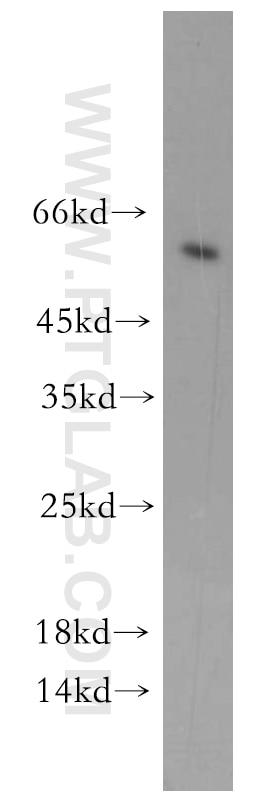CYP4Z1-Specific Polyclonal antibody
CYP4Z1-Specific Polyclonal Antibody for WB, ELISA
Host / Isotype
Rabbit / IgG
Reactivity
human
Applications
WB, ELISA
Conjugate
Unconjugated
Cat no : 20142-1-AP
Synonyms
Validation Data Gallery
Tested Applications
| Positive WB detected in | MDA-MB-453s cells, HeLa cells |
Recommended dilution
| Application | Dilution |
|---|---|
| Western Blot (WB) | WB : 1:500-1:1000 |
| It is recommended that this reagent should be titrated in each testing system to obtain optimal results. | |
| Sample-dependent, Check data in validation data gallery. | |
Published Applications
| WB | See 2 publications below |
Product Information
20142-1-AP targets CYP4Z1-Specific in WB, ELISA applications and shows reactivity with human samples.
| Tested Reactivity | human |
| Cited Reactivity | human |
| Host / Isotype | Rabbit / IgG |
| Class | Polyclonal |
| Type | Antibody |
| Immunogen | Peptide 相同性解析による交差性が予測される生物種 |
| Full Name | cytochrome P450, family 4, subfamily Z, polypeptide 1 |
| Calculated molecular weight | 59 kDa |
| Observed molecular weight | 59 kDa |
| GenBank accession number | NM_178134 |
| Gene symbol | CYP4Z1 |
| Gene ID (NCBI) | 199974 |
| RRID | AB_10666432 |
| Conjugate | Unconjugated |
| Form | Liquid |
| Purification Method | Antigen affinity purification |
| Storage Buffer | PBS with 0.02% sodium azide and 50% glycerol pH 7.3. |
| Storage Conditions | Store at -20°C. Stable for one year after shipment. Aliquoting is unnecessary for -20oC storage. |
Background Information
CYP4Z1 belongs to the cytochrome P450 family. CYP4Z1 catalyzes the reaction: RH + reduced flavoprotein + O2 = ROH + oxidized flavoprotein + H2O. This antibody is specific to CYP4Z1.
Protocols
| Product Specific Protocols | |
|---|---|
| WB protocol for CYP4Z1-Specific antibody 20142-1-AP | Download protocol |
| Standard Protocols | |
|---|---|
| Click here to view our Standard Protocols |
Publications
| Species | Application | Title |
|---|---|---|
Environ Toxicol 1-Benzylimidazole attenuates the stemness of breast cancer cells through partially targeting CYP4Z1 | ||
Mol Carcinog HET0016 attenuates the stemness of breast cancer cells through targeting CYP4Z1. |



